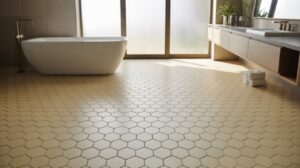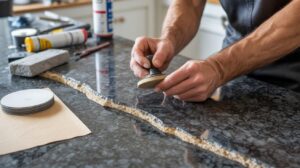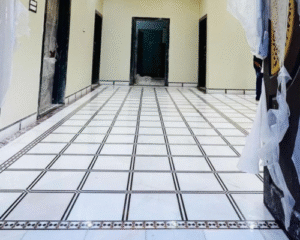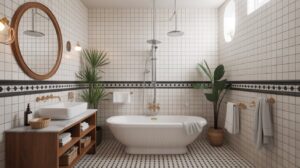Brown Marble Countertops | Elegance and Durability for Kitchens & Bathrooms
Brown marble countertops bring a luxurious blend of elegance, warmth, and durability to kitchens, bathrooms, and various commercial spaces. Known for their unique color variations, brown marble countertops fit seamlessly with a wide range of design styles, from classic to modern. Let’s dive into the benefits, applications, and comparison of brown marble with other popular countertop materials, as well as the cost and installation process for this beautiful natural stone.
Benefits of Brown Marble Countertops
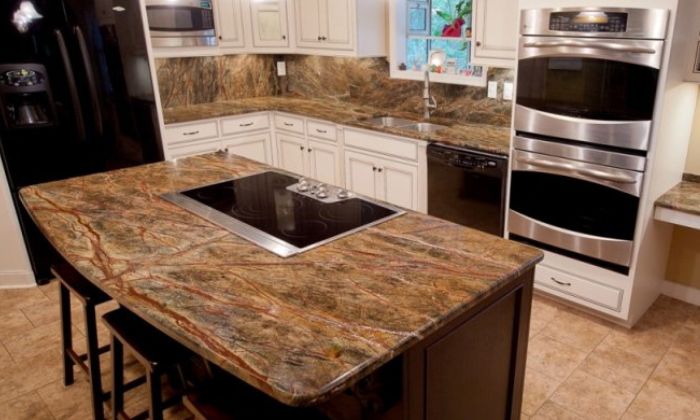
Table of Contents
ToggleAesthetic Appeal
Brown marble countertops offer a natural beauty that elevates any space. The veins of white, gray, black, or gold that run through brown marble add character and charm, making each slab a unique work of art.
Whether you opt for a light brown marble countertop or dark brown marble, the variety of shades and patterns can complement various design aesthetics, including rustic, contemporary, and minimalist. Brown marble pairs beautifully with white cabinets, creating a timeless look in both kitchens and bathrooms.
Durability
Marble countertops are highly valued for their durability. Although slightly softer than granite, brown marble countertops can withstand daily wear and tear when properly sealed and maintained.
They’re resistant to high heat, making them an excellent choice for kitchen countertops near stoves or ovens. However, due to the natural composition of marble, these countertops do require regular sealing to protect them from staining and etching caused by acidic substances.
Versatility
One of the greatest advantages of brown marble countertops is their versatility. Whether you need a bold kitchen countertop, a sophisticated bathroom vanity, or a luxurious commercial installation, brown marble can be tailored to meet your needs.
Brown and white marble countertops, for example, offer an elegant touch to kitchens with white cabinets, while darker shades add drama and sophistication to bathrooms and commercial spaces.
Adds Value to Property
Investing in brown marble countertops can increase the value of your home or commercial property. Buyers are often attracted to the timeless appeal and durability of natural stone materials, especially when paired with stylish elements like an ogee edge for a classic finish.
Marble countertops, especially in popular shades like brown, elevate the perception of the property’s overall quality, making it a desirable choice for real estate investments.
Where to Use Brown Marble Countertops
Kitchen Countertops
Brown marble kitchen countertops add warmth and elegance, making kitchens more inviting. Their versatility allows them to complement various styles, from classic white kitchens to modern gray or black designs.
Light brown marble brings brightness to the space, creating a fresh, open feel, while dark brown marble adds depth and a luxurious richness. Both options balance beauty with functionality, elevating the overall kitchen ambiance.
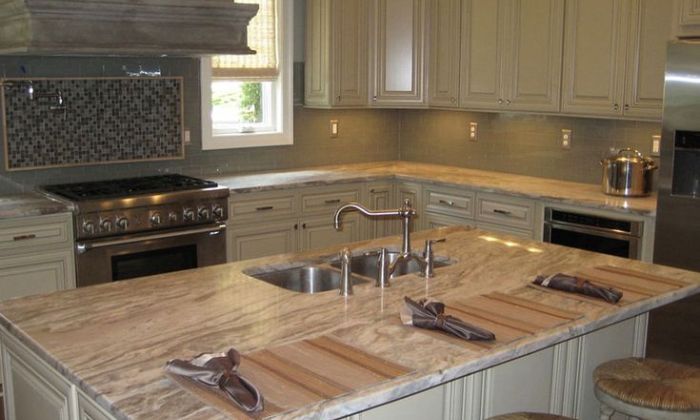
Bathroom Vanities
Brown marble countertops are a luxurious choice for bathroom vanities, bringing both elegance and practicality. Known for their moisture resistance and ability to withstand high heat, they’re perfect for bathroom use.
Pairing brown marble with white cabinets creates a beautiful, spa-like ambiance, transforming a regular bathroom into a sophisticated retreat. Their natural patterns and rich tones add warmth and style, enhancing any bathroom’s aesthetic appeal.
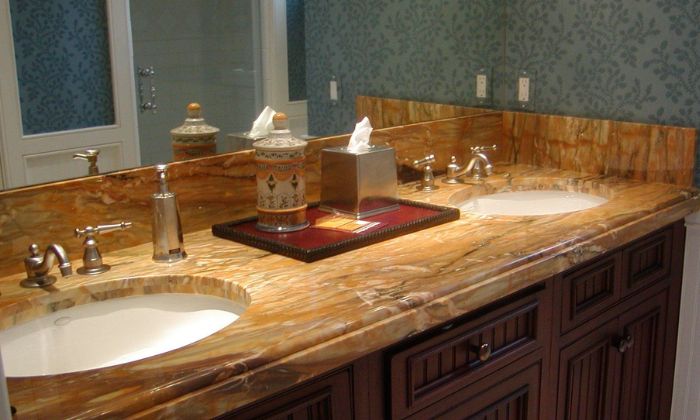
Commercial Spaces
Brown marble countertops bring a refined, luxurious touch to commercial spaces like restaurants, hotel lobbies, and offices. Their natural elegance elevates the ambiance, adding sophistication that resonates with customers and enhances their experience. Marble’s unique patterns and rich tones make each piece distinct, ideal for businesses seeking a memorable, upscale impression.
Brown marble effortlessly blends durability with aesthetic appeal, ensuring a lasting and impactful statement for high-traffic environments. This choice not only supports a polished look but also subtly communicates quality and exclusivity, aligning perfectly with brand identity in upscale commercial settings.
Brown Marble vs. Other Countertop Materials
Brown Marble vs. Granite
While both brown marble and granite countertops are durable and heat-resistant, they differ in appearance and maintenance needs. Granite countertops tend to have a more consistent, speckled appearance, while brown marble offers a more intricate, veined pattern.
Granite is generally less porous than marble, requiring less frequent sealing. However, the natural elegance of brown marble can make it a preferred choice for those who prioritize aesthetics in their kitchen design.
Brown Marble vs. Quartz
Quartz countertops are man-made, consisting of engineered stone, making them highly resistant to stains and scratches. Unlike brown marble, quartz doesn’t require regular sealing, which can be a time-saving benefit. However, quartz lacks the unique patterns and color variations of natural marble, making brown marble a better choice for those who desire a one-of-a-kind natural stone with timeless appeal.
Brown Marble vs. Travertine
Travertine, a sedimentary stone, has a porous surface with natural pits and troughs, making it distinct from the smooth, polished finish of brown marble. While travertine can add a rustic look, brown marble offers a more elegant and luxurious appeal, especially in kitchens and bathrooms. Additionally, brown marble is denser than travertine, making it more durable for high-traffic areas.
Cost of Brown Marble Countertops
The cost of brown marble countertops typically ranges from $50 to $150 per square foot, influenced by factors such as marble quality, color, and origin, with popular varieties like fantasy brown marble often priced differently due to their unique appeal. Additionally, the type and color of the marble can significantly impact the price, with rare or exotic varieties featuring distinctive veining patterns commanding higher costs.
Larger slabs tend to be more expensive as they reduce the need for seams, creating a more seamless look. Furthermore, installation complexity, including custom edges and multiple cutouts for sinks or appliances, can also contribute to the overall expense.
Installation Process for Brown Marble Countertops
Preparation
Preparation is a crucial step in the marble installation process. The installation team begins by accurately measuring your space to determine the precise dimensions needed for the marble slab. This ensures that the slab is cut to fit perfectly, accommodating any specific features of your area, such as corners, edges, and irregularities in the surface.
Proper measurements help prevent costly mistakes and ensure a seamless installation, resulting in a polished and professional appearance. By taking the time to prepare correctly, the installation team sets the stage for a successful and aesthetically pleasing outcome.
Template Creation
Template creation involves crafting a precise outline of the countertop shape, which serves as a crucial guide for cutting the marble slab. This template, typically made from cardboard or a flexible material, is designed to match the exact dimensions and features of the intended countertop. By ensuring accuracy in the template, fabricators can minimize waste and achieve a perfect fit during installation.
The template also accounts for elements like sink cutouts and edges, enabling a seamless integration of the countertop into the kitchen or bathroom space. This step is essential for achieving high-quality results in countertop fabrication.
Slab Cutting
Slab cutting is a crucial step in processing natural stone, where large blocks are transformed into usable slabs for countertops, flooring, and other surfaces. This process utilizes specialized tools, such as diamond wire saws or bridge saws, to accurately cut the stone to the desired size and shape.
Precision is essential to ensure the final product meets design specifications and maintains the material’s structural integrity. After cutting, slabs may undergo additional treatments, such as polishing or sealing, to enhance their appearance and durability. This meticulous approach allows for the creation of stunning, custom stone surfaces for various applications.
Edging and Polishing
Edging and polishing involve refining the edges of stone surfaces to enhance their aesthetic appeal and functionality. Various edge profiles can be selected, including square, ogee, or other decorative designs, each offering a distinct look. The process ensures that edges are smooth and free of sharp corners, making them safer and more visually pleasing.
After shaping the edges, polishing is performed to achieve a glossy finish that highlights the stone’s natural beauty. This finishing touch not only elevates the overall appearance but also protects the edges from chipping or damage, ensuring durability in both residential and commercial applications.
Installation
During installation, the marble slab is carefully positioned and secured onto the designated surface, such as a countertop or floor. The edges are meticulously aligned to ensure a smooth and precise fit. Once the slab is in place, any seams between pieces are filled with a matching epoxy or resin, effectively concealing gaps and creating a polished, seamless appearance.
This process not only enhances the aesthetic appeal of the marble but also contributes to its durability and longevity, making the surface easier to clean and maintain while showcasing the natural beauty of the stone.
Sealing
Sealing is a crucial final step in the countertop finishing process. It involves applying a protective sealant to the surface to create a barrier against moisture, stains, and etching. This sealant helps prevent liquids from penetrating the material, which can lead to discoloration or damage. By sealing the countertop, you enhance its durability and maintain its aesthetic appeal over time.
A properly sealed countertop not only looks better but also simplifies maintenance, making it easier to clean and care for. This essential treatment ensures that the countertop remains functional and attractive for many years.
Elevate Your Space with Expert Installation with Brown Marble Countertops
Transform your kitchen or bathroom into a warm, inviting haven with brown marble countertops that blend timeless beauty and lasting strength perfectly installed by our skilled team. From precise templating to flawless edging and sealing, our Countertops Installation in Lowell service ensures each slab fits seamlessly, highlighting the rich veins and unique hues of your chosen stone. Whether you prefer light-brown whisper tones or deep-chocolate drama, we handle every step cutting, polishing, and final sealing so you enjoy both elegance and durability without compromise.
Conclusion
Brown marble countertops are a fantastic choice for anyone looking to combine elegance, durability, and unique aesthetic appeal. They suit a variety of spaces, from kitchens and bathrooms to commercial environments, and their versatility makes them adaptable to different color schemes and design styles. Although maintenance is required, the value that brown marble adds to your property is undeniable. With its one-of-a-kind veining and range of shades, brown marble is an investment in timeless beauty and quality.
FAQs
What makes brown marble countertops a good choice for kitchens?
Brown marble’s natural warmth and heat resistance make it ideal around stoves, while its unique veining adds character that complements any cabinet color.
How often should I seal my brown marble countertop?
To maintain stain resistance and shine, sealing is recommended every 6–12 months, depending on use and the type of sealant applied.
Can brown marble withstand heavy daily use?
Yes, when properly installed and maintained, brown marble offers excellent durability, though it’s best to use cutting boards and avoid acidic cleaners to prevent etching.
How does the installation process work?
Our process involves precise measurements, template creation, slab cutting, edge profiling, polishing, professional installation, and a final seal delivering a perfect fit and finish.
What is the typical cost range for brown marble countertops?
Costs generally run from $50 to $150 per square foot, influenced by stone variety, slab size (fewer seams), edge detail, and complexity of cutouts.


